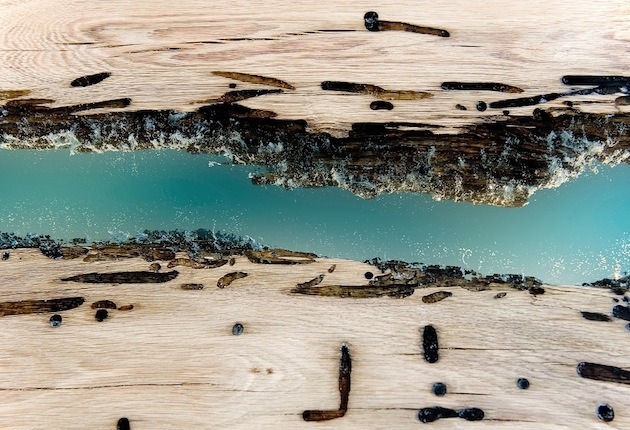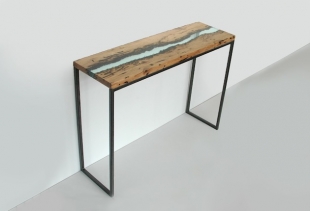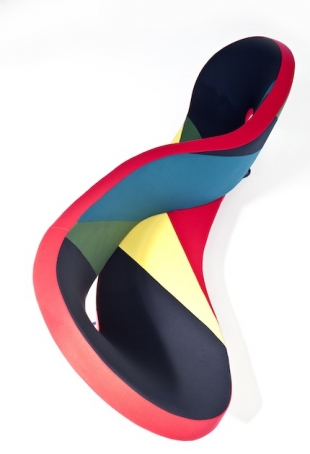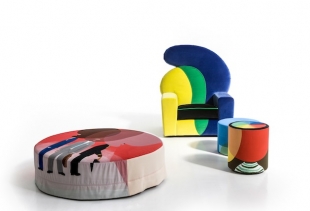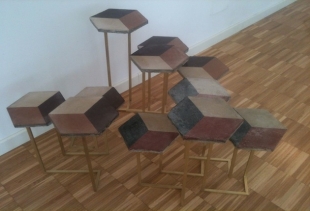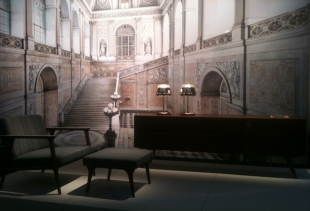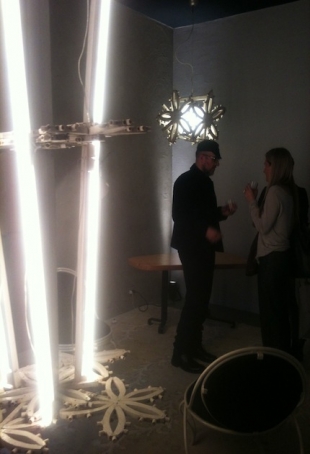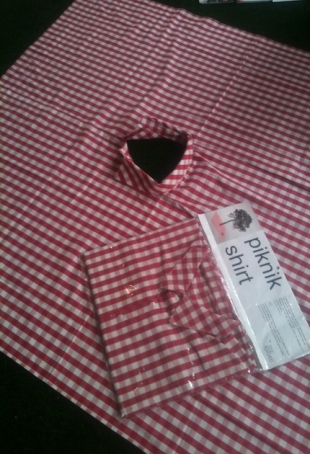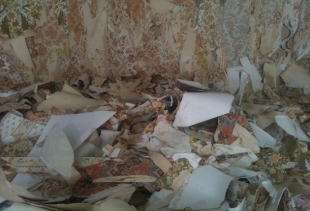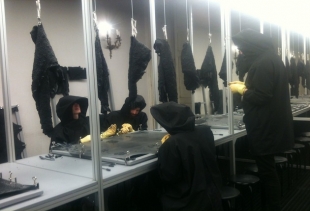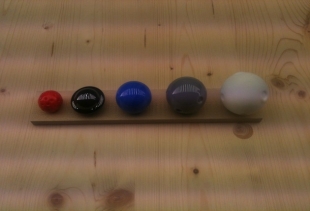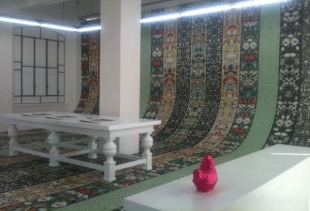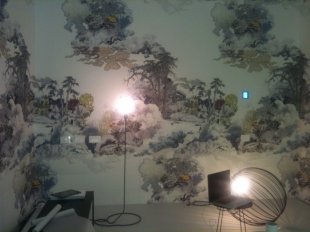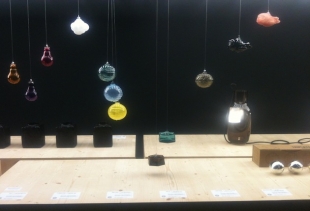» archivio blog
-
Basilea e oltre: temi primari tra arte, teatro, design e collezioni
data: 17-06-2015
-
Intervista a Nicola Toffolini
Inventore di mondidata: 24-04-2011
-
Donne senza uomini.
Installazione multimediale di Shirin Neshatdata: 01-03-2011
An object, after all, is what makes infinity private
Una selezione di proposte dal Fuorisalone di Milano
Un deciso uso del colore pastello, l’atto insistito di forgiare naturalmente la materia, una serie di spunti molto interessanti attorno alla ceramica ed ad un suo uso non convenzionale. Ed ancora, l’intrusione di più linguaggi – con una vivace e matura attenzione al tessile - su uno stesso pezzo d’arredo: queste, anche se non solo, mi sono sembrate le novità più lampanti delle proposte (vieppiù le stesse e deludenti) del Fuorisalone milanese, anno 2014. Le proposte della fiera, soprattutto quelle del salone dedicato alla tecnologia e alla cucina di cui vi parlerò diffusamente in un altro post, sembrano la più valida delle ragioni per tornare ogni anno a Milano.
I buyer si concentrano maggiormente sui padiglioni di Rhò e accorciano la permanenza a tre giorni. I taxi si trovano quasi ovunque e gli hotel non registrano il sold out di dieci anni fa, neanche gli appartamenti che a raggio vengono affittati da chiunque durante la Design Week. Una città bella come sempre, stavolta baciata dal sole, ha accolto dunque la popolazione internazionale del cerchio o del circo del design. Andiamo con ordine, per qualche suggestione da portarsi sul desk tutti gli altri giorni dell’anno.
La materia, un patto scritto negli anni con i propri clienti ed amanti, uno storytelling adeguato e affascinante è da Citizen e Baccarat. L’azienda giapponese di orologi incanta alla Triennale di Milano dove porta un’installazione immersiva fatta con la placca che chiude la cassa degli orologi (in mostra i più nuovi prodotti , gli orologi Fast-ER collegati al satellite, che raccontano sempre l’ora esatta a qualsiasi latitudine ci si trovi e che perfezionano il percorso iniziato con il primo orologio di questo tipo, allora “radio”, a marchio Citizen e datato 1995). A Maison&Objet Singapore Citizen ha presentato il primo orologio di plastica ad energia solare, alla Triennale (e nel catalogo della mostra, Better Starts, scritto solo e soltanto da impiegati della compagnia, nessun critico o famoso giornalista: solo le voci di chi quegli orologi li fa) ritroviamo la versione in acciaio, Smart-ER che si ricarica da solo mentre lo indossiamo al polso. Il creative director Marie Yoshida, membro del Brand Head Office, ha affermato (mentre mi ha guidato alla visione della mostra): “Non è solo una questione di advertising, siamo convinti che il nostro prodotto, per come è concepito e per la storia di innovazione di cui si compone, è prima di tutto una scelta di lifestyle e poi un orologio. E’ la prima volta che organizziamo una mostra del genere e siamo stati convintissimi nello scegliere Milano e la sua Design Week.”
La Triennale di Milano ospita ancora una volta Belgium is Design, stavolta interamente concentrato sul rapporto tra superfici riflettenti e luci (un’altra sezione è anche al Salone Satellite): per scoprire meglio il fenomeno del design in Belgio, le edizioni Luster hanno dato alle stampe (e presentato in Triennale) Belgium’s Best Design (in tre lingue di cui parleremo in una prossima recensione tutta dedicata al volume).
Baccarat abbandona il quadrilatero della moda e per il 250mo anniversario sceglie la filantropia e l’Accademia di Brera con la sua chiesa di San Carpoforo per una mostra celebrativa, opulenta ed intensa di ogni sua suite per la casa: dalla cristalleria da drink in più evoluzioni cromatiche (su cui spicca il rosso rubino), fino all’arredo-tavola e all’illuminazione, scegliendo nuance e forme decisamente barocche e classiche, accompagnate da arredi in pietra che abbandonano quel minimalismo algido che ha contraddistinto le ultime esposizioni milanesi. La mostra dura fino ad oggi, come tutte le altre del Fuorisalone.
Altro anniversario, altra azienda: Marimekko: 50 anni dalla creazione di un pattern floreale brillante ed allegro (Unikko), che nacque per protesta di una designer che si rifiutò di bandire i fiori dal catalogo dei prints e che genera tuttora un grande riscontro del pubblico. Tanto da far proseguire questa mostra – una coloratissima nuvola di soffici cuscini ricoperti delle stoffe in catalogo primavera/estate 2014, anche oltre Unikko: pattern grafici in cui il rosso, le bande e i puntini in serie la fanno da padrona - in varie città del mondo (dopo Milano). Marimekko è in Italia da Jannelli&Volpi mentre per il Fuorisalone ha scelto un corner da Rossana Orlandi in via Matteo Bandello, dove troviamo tutte o quasi le proposte dello scorso anno (mentre la sua mostra al Palazzo Bagatti Valsecchi - Untold fino al 6 maggio - sponsorizzata da Goga Ashkenazi con la sua Vionnet e coadiuvata da Marta Sala, ex Azucena ora parte del team Orlandi, è più interessante e corposa). Tra le proposte dei giovani, merita una menzione quella dei bellunesi Alcarol (al secolo Andrea Forti ed Eleonora Dal Farra: una coppia di giovani architetti nella vita e nel lavoro). Già presentato al London Design Festival, il loro catalogo consiste in pezzi di bricole (i pali per le barche e per la delimitazione dei canali della laguna veneta), intrusi in resina per formare solide e cangianti superfici che riproducono esattamente la vita di prima della bricola: a fondo nel mare verde della laguna. Prezzi dei tavoli dai settemila euro e possibilità infinite di customizzazione: la citazione che da il titolo a quest’articolo è quella scelta dai giovani autori come massima della poetica di questa collezione. E’ dello scrittore Iosif Brodskij, autore di Fondamenta degli Incurabili e grande amante di Venezia, dove chiese di essere seppellito.
Ancora pattern cangianti, stavolta su vetro soffiato, al Centre Cultural Francais, dove la mostra Le Feu Sacre (che dura fino al 16 maggio) porta a Milano una storia di saper fare e anche di un successo, in fondo, sulla desertificazione industriale. La regione del Meisenthal, dove una vetreria del 1704 ha chiuso i battenti nel 1969, ospita il Centre International D’Art Verrier che ha riacceso i forni nel 1992. La mostra mischia giovanissimi e più famosi tra artisti e designer: gli oggetti di vetro cristallo di Andreas Brandolini (eleganti fermacarte) accanto alle invenzioni pezzi/unici di Ferreol Babin (classe 1987) fino al mio preferito, System, una collezione (portatile, da desk) di cinque pianeti firmata dal giovane studio Big Game. Elric Petit, Grégoire Jeanmonod, Augustin Scott de Martinville (uno francese, uno svizzero e uno tedesco, nati tra il 1978 ed il 1980) affermano che System è soprattutto un oggetto che può abituarci ad un nuovo approccio con il mondo ed a nuove conquiste dello spazio (mentali).
Una grande e prolifica immersione concettuale sulla auto-produzione e sui legami tra essa e le tradizioni manifatturiere dei territori e delle loro culture, si trova nello splendido Palazzo Clerici in collaborazione con Z33 e DAMn Magazine dove alcuni giovani designer (come Formafantasma che porta una collezione già presentata a Basilea con Libby Sellers: orologi orizzontali fatti di sabbia vulcanica) si affiancano a proposte più viabili (come un monoblocco da tavolo e da bagno, Islands, firmato Raw&Edges per Ceasarstone). Mi ha colpito Work With Me People III, un’installazione performativa di MU (una galleria) e dell’artista Bart Hess (già presentata alla Dutch Design Week e alla Fashion Biennial di Arnhem): gli artisti creano una complicata superficie futuristica fatta di estrusioni e stretching di colate di resina plastica. Mentre lavorano, parlano con un voice fader che trasforma ogni parola in sussurro. Chissà se si sono resi conto di essere i veri provocatori “sul fare” della Design Week…Tanto per cominciare: in un ambiente bianco, tutto il resto è total black, dalla stoffa futuristica che i performer lavorano. Fino alle loro tute da astronauta che nascondono i visi e le mani.
Moroso chiama Martino Gamper che risponde creando magici e poliformi divani con le illustrazioni giocose dell’artista Peter MacDonald (i due sono amici e vicini di casa). Già iniziata con Metamorfosi, la collaborazione tra l’artista e l’azienda friulana continua nel senso del perfezionamento del background “tecnologico” dei nuovi pezzi Chair Lift: divani morbidissimi eppure solidissimi, in schiuma espansa dall’anima rigida, il peso consistente, i colori vivaci e le forme eccentriche. Lo showroom, spoglio e dalle pareti sverniciate, era popolato da una ventina di pezzi e tutte le persone si sedevano a decine: un vero salotto da conversazione!
I colori intesi non solo come campiture ma come geometrie, volume e movimento (stavolta tenui e pastello), sono protagonisti di tre creazioni tra di loro diverse eppure affluenti ad un’idea quieta e fiduciosa di design: Marco Guazzini presenta Facade e Flamingo. Il primo è un vaso di cemento dai colori insistenti e dal perimetro innovativo, che permette infinite configurazioni ed accostamenti sia agli stessi vasi sia ad altri di famiglie diverse. Il secondo è una console cinetica, si ispira all’omonimo uccello (che vive a Miami, ecco i colori della console) e si muove a seconda delle esigenze di chi la utilizza (consentendo lo scivolamento dei cassetti/contenitori).
Alfredo (firmato da Tagmi) è un tavolo da pranzo performante per preparare nuove ricette: eco dei tavoli da cucina delle massaie italiane degli anni 50, ricorda anche che un posto a tavola per l’IPAD è d’obbligo oggi.
La neonata collezione Clique Smart Matters, idea di designer italiani (tra cui Claudio Larquer e Simone Simonelli) mette insieme due aziende (Odone Marmi e Lilea Design) e l’energia di materiali nobili (come il legno ed il marmo) con uno tecnlogico (il valchromat). Oltre all’elegante palette di colori (prevale il blu, colore del brand neaonato), ogni arredo è “elettrico” e quindi utilizzabile con smart-phone e altre device di uso comune. Visti, tra gli altri, sedute con ricarica-telefoni wireless; tavoli con rocchette di filo e presa elettrica mobile, libreria con speaker bluetooth in marmo, una minicucina con dock per tablet e piastra a induzione…
Chiudiamo questo piccolo post, che magari vi permette di girare per il Fuorisalone con qualche spunto in più nelle restanti ore di apertura delle mostre, con la storia proposta da due maestri, molto diversi tra loro per età e per stile: Marcel Wanders e Francesco Binfarè.
Marcel Wanders, nel suo showroom di Via Savona 56 (aperto tutto l’anno), chiama Massimo Listri (1973), grande fotografo di interior per collaborare con visual che l’anno scorso furono di Erwin Olaf. Colore, materia e tessili di grande gamma, forme affini all’uovo e giocose, tappeti vivacissimi complementano i lavori dello stesso Wanders e di altri autori come Pot, Zupanc, Studio Job. Ogni gruppo di arredi viene presentato come un piccolo living, con backstage una straordinaria foto di Listri che inquadra sontuosi palazzi o musei italiani.
Insieme a Casper Vissers ricorderete che si è ricomprato la maggioranza di MOOOI da B&B: ottima scelta, ha cambiato decisamente gusto ed è ritornato ad una politica di prezzi più aggressiva che però facilita anche l’acquisto a giovani che vogliono arredi di design e che prima non potevano permettersi un pezzo MOOOI. Il mio preferito è il Love Seat, divano da due avvolgente e pieno di cuscini anche in una versione bianca con pelliccia (sintetica). Un vero e proprio nido.
Per chi andrà ad Amsterdam, fino al 15 giugno lo Stedelijk Museum ospita una grande retrospettiva di tutti i suoi più famosi lavori.
Francesco Binfarè chiama gli amici più cari e mostra, nella sua bellissima casa in zona Porta Venezia che condivide con la sua compagna di vita (e di Biodanza: Silvia Signorelli, poetessa oltre che manager di una nota scuola di design milanese), una collezione dal sapore filosofico che gioca sul pieno e sul vuoto, sul cuore e sul perimetro, sui miti e sulle costellazioni, frutto di un sapere ebanista e di un chiaro amore per il legno.
Sebbene sia stata visitabile soltanto il 10 aprile con una curatissima private view in cui il designer stesso raccontava l’origine di ogni creazione, potete contattare Francesco Binfarè per avere un’altra private view: un tavolo con cornice, una credenza buffet ed altre creazioni (soprattutto i suoi famosi divani bestseller per grandi aziende italiane, tra cui Cassina, di cui è stato a lungo direttore del Centro Ricerche, oppure Edra ed ancora tutte le sue creazioni in collezione al MOMA) vi accoglieranno nel delizioso appartamento con una terrazza fiorita di tante specie e magicamente sormontata da una cascata di glicini, vera tempesta olfattiva di questa assolata design week milanese.
Se seguite il nostro account FB, tutta la prossima settimana vi racconteremo, per immagini, le altre novità, degne di nota, del Fuorisalone: da studi emergenti a raffinati autori che non sono già citati nella corposa gallery di questo post con un focus particolare sulla ceramica per mano di giovani autori che vengono da tanti continenti e che portano con loro saperi e tecniche diverse, entusiasmanti.

